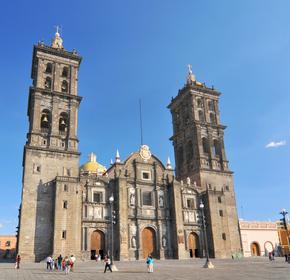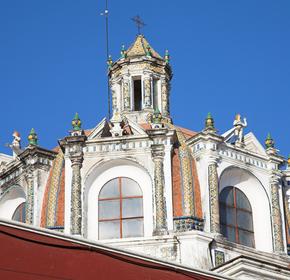
Puebla City travel guide
Puebla City Tourism | Puebla City Guide
You're Going to Love Puebla City
With its incredible colonial center and a stunning setting cradled in a range of snow-dusted peaks, Puebla is one of Mexico's most beautiful cities. Add in great food, music, and a huge Cinco de Mayo Festival, and the result is a superb vacation destination.
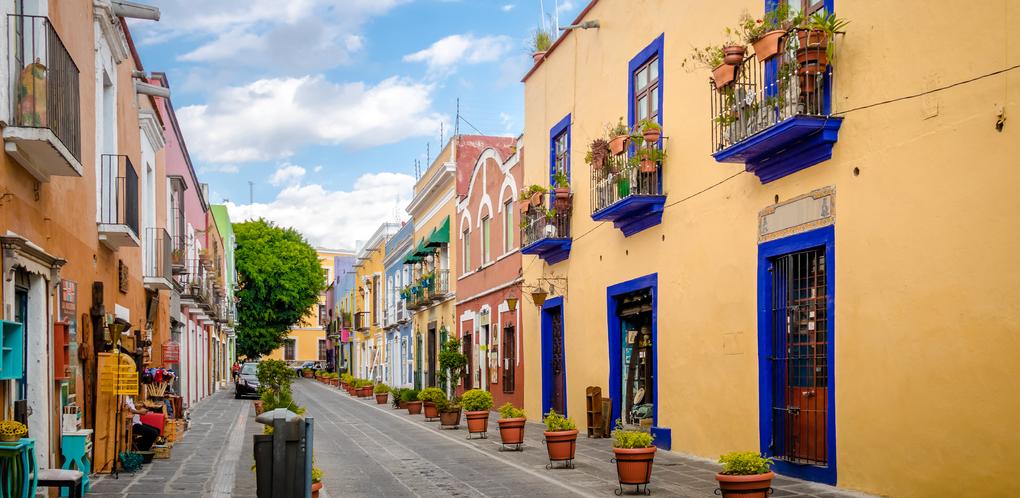
Top 5 Reasons to Visit Puebla City
1. The Old Colonial City
Puebla was born in 1531, as the Spanish sought to exert control over central Mexico, and became the second city of Colonial Mexico. The legacy is around 1,000 colonial buildings, most of them around the Zocalo.
2. Cinco de Mayo
Puebla's Cinco de Mayo celebrates the Battle of Puebla in 1862 when Mexican forces defeated the French. Nowadays, the victory is celebrated in style with fireworks, food, and parades aplenty.
3. Pick Up Some Cut-price Masterpieces
Puebla has a thriving artistic community centered around the Los Sapos neighborhood, where you can buy paintings and sculptures at bargain prices.
4. Excellent Museums for History and Art Lovers
The Museum of the Revolution is a highlight, but don't miss the lavish colonial interior of the Museo Casa del Alfeñique and the Museo Amparo, which deals in pre-colonial artifacts.
5. Party All Night at the Antros
Puebla is a nightlife hub, and evening entertainment centers around its "Antros" - bars and clubs in areas like Los Sapos or Cholula.
What to do in Puebla City
1. Catedral de Puebla: Mexico's Second-Largest Cathedral
Dedicated to the Immaculate Conception, this church's grayish architecture was inspired by Renaissance, Baroque, and Neoclassical art. Inside the church, you'll be amazed by the 14 Baroque lateral chapels and the "Major Altar" designed by Manuel Tolsa. Flanked in the middle of the right and left aisles, marvel at the central nave and the "The Assumption of the Virgin" painted inside the chapel's dome. Listen to the music sung by the church choir, a late 16th-century tradition. After that, climb one of the two 226-foot-tall bell towers and get a bird's-eye view of the spectacular cityscape.
2. Amparo Museum: Mexico's Most Prestigious Historical Museum
The Amparo Museum is housed in two colonial structures dating back to the 17-18th Century. Stroll the halls of the pre-Classical period and marvel at the Paleo-Indian antiquities depicting the story behind the first Maya collapse. As you peruse the Spanish Conquest exhibition, you'll be transported back to 1517 when the Spanish began their campaign to arrive in Yucatán and conquer the Aztec. Among the most precious antiquities in the museum are the Teotihuacan, Huasteca, Totonac, and Maya jars, figures, altars, utensils, and sculptures.
3. Capilla del Rosario: Chapel of the Rosary
Built in 1690, this Baroque styled chapel is housed in the Santo Domingo Dominican church and convent. Decorated in white and gold texture, the chapel has a 23-carat gold leaf attached to its altar. Marvel at its exquisite design and decorations that have not been disturbed in 300 years. As you stroll through the chapel's corridors, peruse at the six biblical paintings hung on the chapel walls. Each painting features Gozos de la Virgen, Mary's presence during some of Jesus' most recognized stories.
4. Zócalo de Puebla: The Best-Preserved Square in Mexico
Take a stroll to Puebla's main square located in a spacious park frequented by tourists and locals alike. Take in the culture of the spectacular surrounding architecture. You'll marvel at the contrast between the Square's modern buildings and the Spanish Baroque style of archways, the Town Hall, and the Puebla Cathedral. Sit on a bench and admire the urban beauty and experience the hustle and bustle of daily life, or grab a coffee at one of the many restaurants and cafes that line the square.
5. Museo Internacional Barroco: The International Baroque Museum
This magnificent museum combines Baroque art with history, society, and space. Prior to stepping inside the museum, examine the white exterior's elegant curves and intricate detail. Inside, stroll over to The Allegories of Knowledge permanent exhibit and marvel at the science, philosophy, and other material debated among theologians of the era. Then, learn about Baroque theater at the Theatrum Mundi exhibit. After touring the museum, stop at the Museum Shop and purchase gorgeous local folk art or quality branded museum products. Finish off the day by dining at the museum's restaurant with traditional Mexican cuisine.
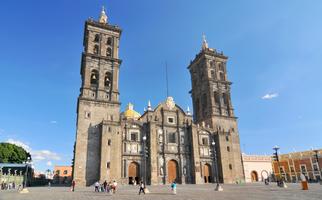
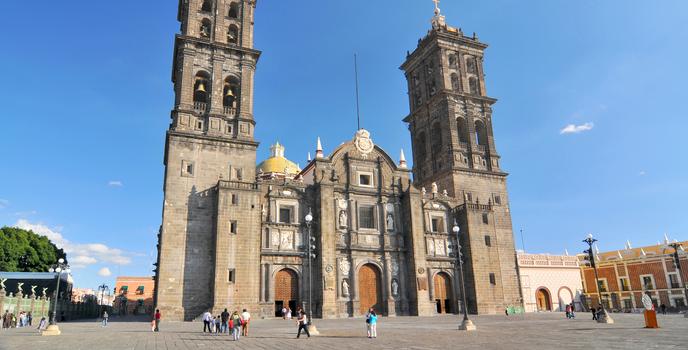




1. Catedral de Puebla: Mexico's Second-Largest Cathedral
Dedicated to the Immaculate Conception, this church's grayish architecture was inspired by Renaissance, Baroque, and Neoclassical art. Inside the church, you'll be amazed by the 14 Baroque lateral chapels and the "Major Altar" designed by Manuel Tolsa. Flanked in the middle of the right and left aisles, marvel at the central nave and the "The Assumption of the Virgin" painted inside the chapel's dome. Listen to the music sung by the church choir, a late 16th-century tradition. After that, climb one of the two 226-foot-tall bell towers and get a bird's-eye view of the spectacular cityscape.
2. Amparo Museum: Mexico's Most Prestigious Historical Museum
The Amparo Museum is housed in two colonial structures dating back to the 17-18th Century. Stroll the halls of the pre-Classical period and marvel at the Paleo-Indian antiquities depicting the story behind the first Maya collapse. As you peruse the Spanish Conquest exhibition, you'll be transported back to 1517 when the Spanish began their campaign to arrive in Yucatán and conquer the Aztec. Among the most precious antiquities in the museum are the Teotihuacan, Huasteca, Totonac, and Maya jars, figures, altars, utensils, and sculptures.
3. Capilla del Rosario: Chapel of the Rosary
Built in 1690, this Baroque styled chapel is housed in the Santo Domingo Dominican church and convent. Decorated in white and gold texture, the chapel has a 23-carat gold leaf attached to its altar. Marvel at its exquisite design and decorations that have not been disturbed in 300 years. As you stroll through the chapel's corridors, peruse at the six biblical paintings hung on the chapel walls. Each painting features Gozos de la Virgen, Mary's presence during some of Jesus' most recognized stories.
4. Zócalo de Puebla: The Best-Preserved Square in Mexico
Take a stroll to Puebla's main square located in a spacious park frequented by tourists and locals alike. Take in the culture of the spectacular surrounding architecture. You'll marvel at the contrast between the Square's modern buildings and the Spanish Baroque style of archways, the Town Hall, and the Puebla Cathedral. Sit on a bench and admire the urban beauty and experience the hustle and bustle of daily life, or grab a coffee at one of the many restaurants and cafes that line the square.
5. Museo Internacional Barroco: The International Baroque Museum
This magnificent museum combines Baroque art with history, society, and space. Prior to stepping inside the museum, examine the white exterior's elegant curves and intricate detail. Inside, stroll over to The Allegories of Knowledge permanent exhibit and marvel at the science, philosophy, and other material debated among theologians of the era. Then, learn about Baroque theater at the Theatrum Mundi exhibit. After touring the museum, stop at the Museum Shop and purchase gorgeous local folk art or quality branded museum products. Finish off the day by dining at the museum's restaurant with traditional Mexican cuisine.






Where to Eat in Puebla City
From quesadillas to corn cobs smothered in cheese and mayonnaise, Puebla's street food is a highlight of the city. There are also some exceptional restaurants, including the vegetarian paradise La Zanahoria, the taco maestros at Las Ranas, and the classy Meson Sacristía de la Compania. Meals will cost around Mex$80-100 per head.
When to visit Puebla City
Visiting around May 5 is obviously a possibility, given the flamboyant festivities. However, for thinner crowds and good weather, September and October are ideal.
How to Get to Puebla City
Plane
Hermanos Serdán International Airport (PBC) offers connections to US cities like Dallas and Houston. From there, local buses cost just Mex$6 and taxis will charge around Mex$40.
Car
From Mexico City or Veracruz, just take Highway 150D straight to Puebla.
Bus
Buses run into central Puebla from Mexico City every hour and charge between Mex$160 and Mex$200 depending on the time of day. The journey only takes around two hours.
Airlines serving Puebla City
Where to stay in Puebla City
The Zocalo - Puebla's city center, the Zocalo is Mexico's best preserved colonial square. Flanked by the stunning Cathedral, it hosts rotating art exhibits.
Popular Neighborhoods in Puebla
Los Sapos - home to Puebla's artistic community and plenty of bars, Los Sapos is the place to head for a good time.
Cholula - around 10 miles outside the city center, Cholula is famed for its dance clubs and is a fascinating place, with Aztec ruins, splendid churches, and modern architecture to explore.
Where to stay in popular areas of Puebla City
Most booked hotels in Puebla City
How to Get Around Puebla City
Public Transportation
Puebla's public buses charge a basic fare of Mex$6 and run from 7 am until 10 pm.
Taxi
Taxis are a good way to get around Puebla. Expect a meter drop of Mex$35, followed by Mex$15 per mile after that.
Car
Rental companies in the city include Budget, Avis, and Sixt, and rates can be as little as Mex$250 per day.
The Cost of Living in Puebla City
Shopping Streets
Head to Los Sapos for artworks, seek out Talavera ceramics around the Zocalo, or look for hand-made notebooks in the San Pablito neighborhood.
Groceries and Other
Local supermarkets include Chedraui and Costco, and 12 eggs will cost you around Mex$35.
